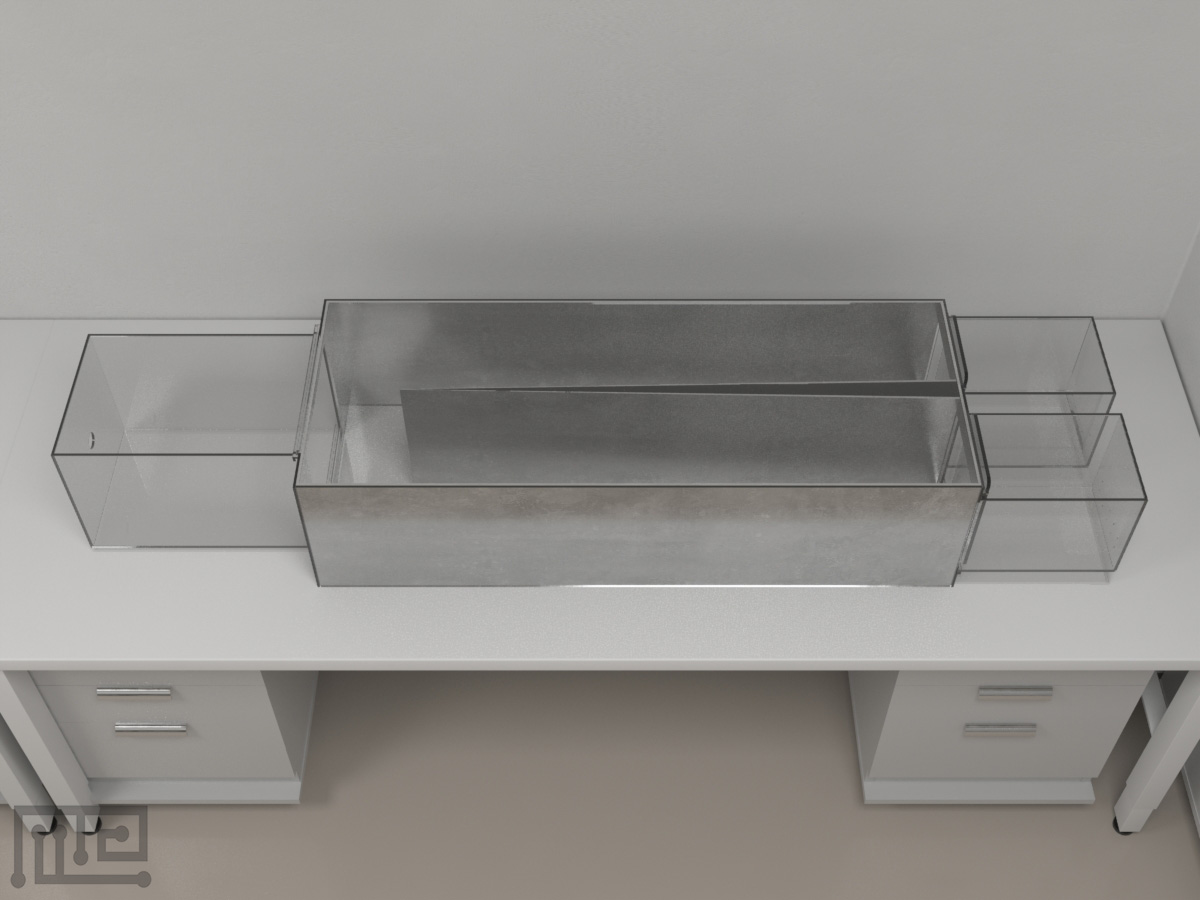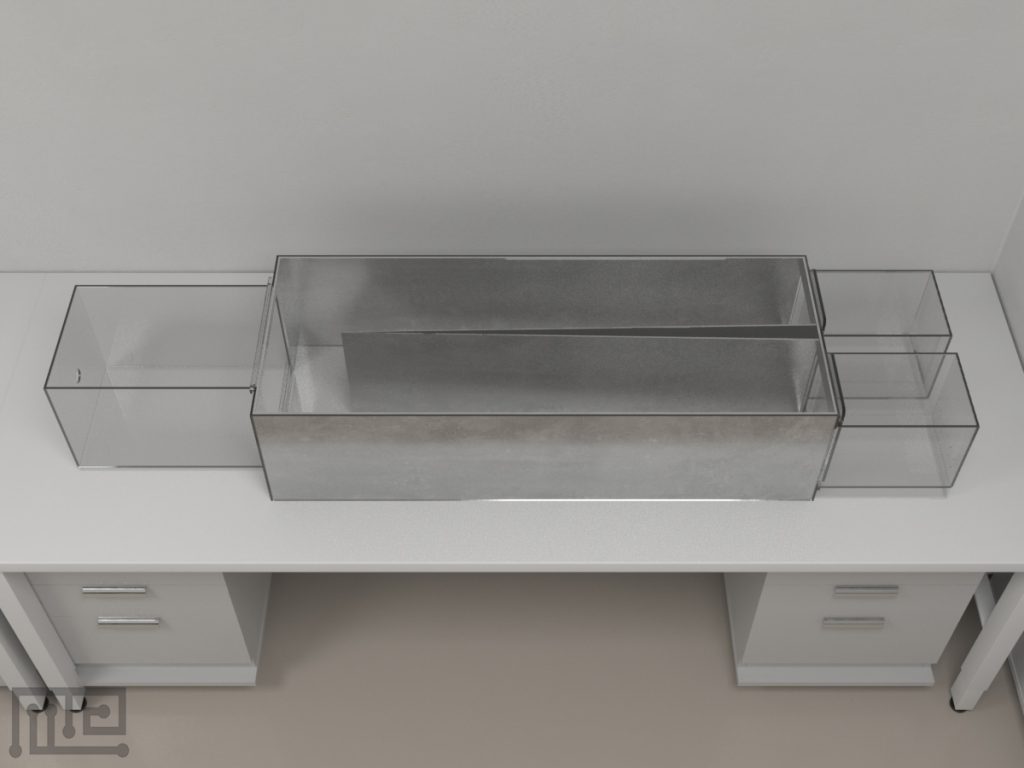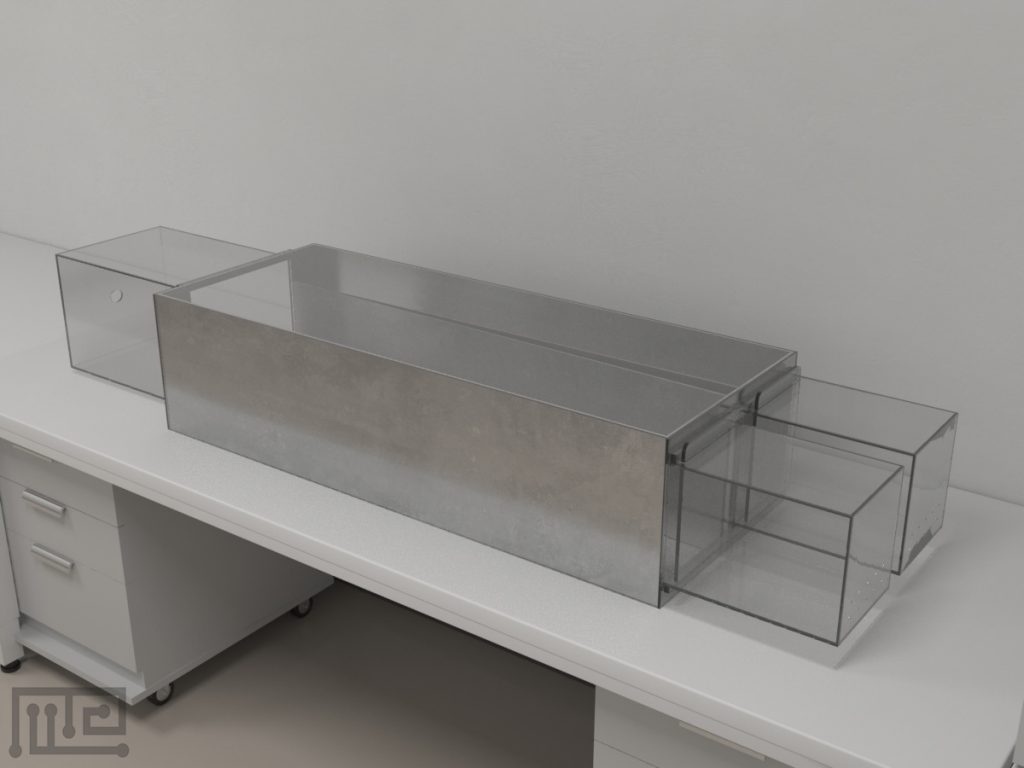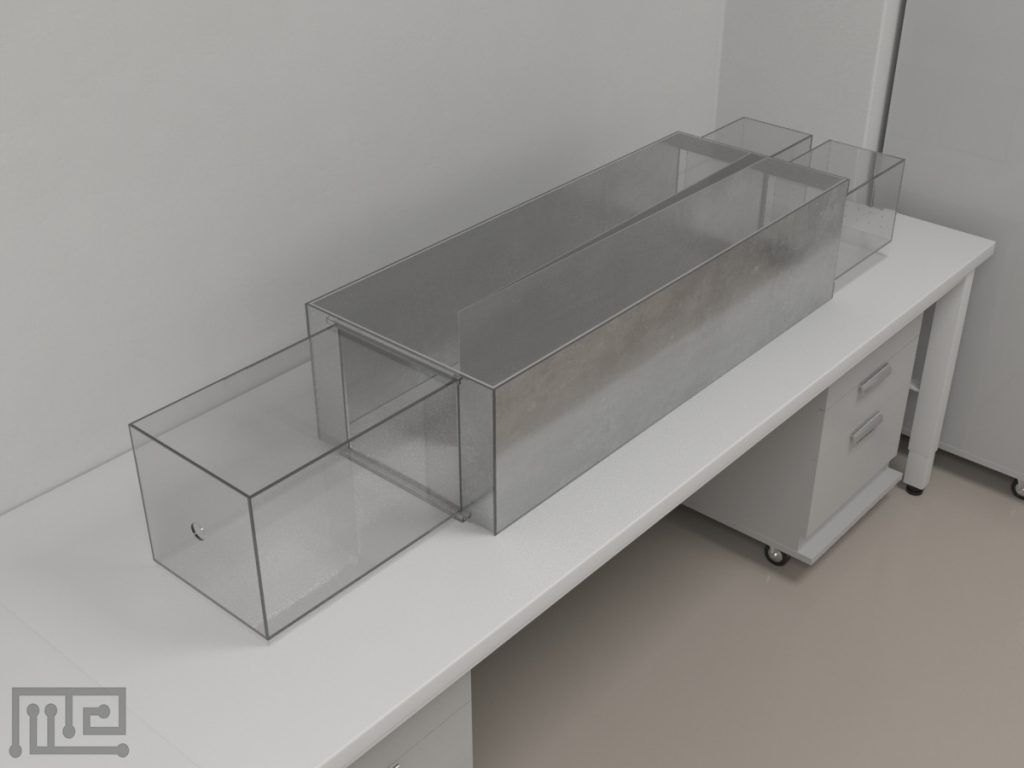The Ferret Y Maze was used by and assess the contribution of conspecific odors, either alone or in combination with visual and auditory signals, to heterosexual partner preference in ferrets.
The maze is constructed to allow for the independent presentation of odor as opposed to odor plus visual plus auditory cues from conspecifics.
It was constructed of stainless steel and was covered with airtight Plexiglas panels.An exhaust fan vented out of the room was used to pull air through the goal boxes (which contained stimulus ferrets) and into the choice area and start box of the Y maze. Plexiglas doors of the two goal boxes were either transparent (allowing subjects to see stimulus animals) or opaque.
The two goal boxes could be exchanged so that the source of stimulus odors could be easily switched without unwanted odor contamination.
Mazeengineers offer the Ferret Y Maze.
Price & Dimensions
Ferret Y Maze
$ 1990
+S&H- Height of goal boxes: 31cm
- Width of goal boxes: 31cm
- Length of choice area: 122cm
- Width of choice area: 91cm
- Length of start box: 46cm
Documentation
Introduction
Ferret Y-maze is used to assess the contribution of conspecific odors, alone or in combination with auditory and visual cues, to mate recognition and preference in ferrets (Mustela furo). Ferret Y maze is a modified form of rodents Y maze and locust Y maze. It consists of a start box connected to two choice boxes. The choice boxes are further attached to goal boxes which contain stimulus ferrets. The acrylic ferret Y-maze apparatus is covered with airtight acrylic panels.
The subjects housed in rabbit cages for a long-day photoperiod are gonadectomized. Animals of both sexes are then injected with sex steroids to imitate the breeding behavior of normal ferrets. Bilateral nares occlusion is performed, and peripheral anosmia is produced by zinc sulfate irrigation of olfactory mucosa. The subjects are exposed to a “food-motivated peppermint odor discrimination task.” Then nares occluded and sham occluded ferrets are tested for partner preference in the ferret Y-maze. The test results are then subjected to statistical analysis.
Apparatus and Equipment
Ferret Y maze test arena is an acrylic, Y-shaped apparatus consisting of a start box/short arm (46cm long), connected to two long arms, each of which is 122cm in length. Each long arm is connected to a goal box (31cm long) to contain the stimulus ferret. The apparatus is 91cm wide.
Airflow through the maze is directed from the goal boxes to the choice boxes and then towards the start box before venting out of the room. The door of the goal boxes is either opaque, to provide odor only cues or transparent to provide odor plus auditory and visual cues.
An exhaust fan vented out of the room was used to pull air through the goal boxes. Goal boxes are exchangeable to ensure the switching of stimulus odors without contamination. The whole apparatus is covered with airtight acrylic glass panels.
Training Protocol
General Preparations
Pre-pubertal male and female ferrets of 12 to 16 weeks are housed individually in modified rabbit cages under a long-day photoperiod, i.e., a 16 hours light cycle and an 8-hour dark cycle. The subjects are fed on ferret chow just once a day only for 45 minutes immediately after the Y-maze session.
Males are castrated, and females are ovohysterectomized under topical anesthetic ketamine (35 mg/kg) and xylazine (12 mg/kg). To ensure full masculine and feminine sexual behaviors and maintain plasma levels of gonadally intact ferrets, sex steroids are given to both sexes. Males are daily injected with testosterone propionate (TP; 5 mg/kg, s.c.) in sesame oil, whereas females received estradiol benzoate (15 mg/ml, s.c.).
Bilateral nares occlusion procedure is used to induce peripheral anosmia for an indefinite period to assess the ability of auditory, visual and somatosensory stimuli as well as coital experience to compensate for the effects of anosmia on mate choice. Two methods can induce nares occlusion:
- Zinc Sulfate Irrigation of olfactory mucosa: used frequently and is effective for 4 to 5 days
- Olfactory Bulbectomy: Not so common as it can cause alterations in social behavior
Pre-training
The subject is exposed to four pre-operative and two postoperative trials in pre-training sessions. Pre-operative trials are conducted before surgery, and postoperative trials are usually held five days after surgery. Meanwhile, the ferrets are kept food-deprived and are fed for only 45 minutes once a day after the Y-maze session. In the trials, the subjects are allowed to choose between two goal boxes, one of which is empty and the other contains a reward. The training procedure includes the following steps:
- Keep one of the goal boxes empty and put 1gm of a supplement paired with peppermint odor. To present distinctive peppermint odor, take two gauze pads and put 1ml of pure peppermint extract on these pads. Tape the gauzes to the inlet and outlet air vents of the goal box containing the supplement.
- Allow the subject to explore Y-maze for 5 minutes and then expose it to 10 “free” trials and 9 “guided” trials.
- In the free trials, place the subject in the start box for 1 minute. Then raise the door of the box and allow the subject to choose and reach either of the goal boxes (left or right). Record the choice and latency of the subject. Open the door of the goal box to let the animal eat the reward.
- Return the subject to the start box to run a guided trial.
- In the guided trial sessions, block the path to the goal box previously chosen by the animal during a free trial, and let it choose the other goal box forcefully.
Note: Intersperse guided trials with free trials to provide ferrets with non-olfactory cues to identify the location of the reward-containing goal box.
- Switch the goal boxes at least three times during trials to eliminate the possibility of memory-based response.
- For every post-switch trial, immediately record the subject’s ability to identify the location of baited goal box with the help of peppermint odor. Calculate the mean percentage of correct choices and separately analyze the data for males and females using a two-way ANOVA test.
Testing Procedure
After the postoperative distinctive peppermint odor assessment task, the subjects are exposed to partner preference tests. The testing procedure can be run as follows:
Note: The rules for the testing procedure are the same as that of training sessions.
- To assess the contribution of odor only stimulus to partner preference, present volatile odors from stimulus ferrets to the sexually naïve subjects. To accomplish this, anesthetize the gonadally intact male or female ferret (in breeding condition) in the respective goal boxes behind opaque doors. Run the first three test sessions in this way.
- In the next three sessions, assess the contribution of odor and auditory and visual cues to mate preference. Place an awake male or female stimulus ferret in each of the goal boxes behind transparent acrylic glass doors and repeat the test as directed above.
- After the completion of the second series of tests, assess the subjects for coital behavior.
- Test all subjects again for their sexual preference for male or female conspecifics based on odor-only stimuli followed by odor plus auditory plus visual cues.
- Finally, allow the subjects to choose between approaching and physically interacting with the mate of their choice (estrous female or stud male tethered to respective goal boxes) for 30 seconds.
- Record the choice and latency of the subject after each trial.
- Run eight free and seven guided trials daily. Thus, run a total of 28 free trials and 21 guided trials.
- Switch the position of the goal boxes, however, avoid frequent switching to ensure that the subject is maximally aware of the stimulus’s location.
- Wash the apparatus with soap and water and then clean with 70% ethanol between the sessions.
- Compute approach latency scores for each subject based on free trials and analyze the data for both sexes separately using two way ANOVA test. Use a two-tailed t-test for between-group comparison of trials’ results in which physical interaction with stimulus ferrets is allowed.
Note: Terminate the individual trial if the subject does not make any choice after 180 seconds.
Literature Review
Nares Occlusion Eliminates Heterosexual Partner Selection without Disrupting Coitus in Ferrets of Both Sexes
Kelliher and Baum used an airtight ferret Y-maze to assess the involvement of odor alone and odor plus auditory and visual cues in the heterosexual partner preference of ferrets. They gonadectomized sexually naïve ferrets and then treated the subjects with sex steroids. The nares of the subjects were either bilaterally occluded or sham-occluded. The animals were then exposed to an airtight Y-maze to examine the effect of olfactory cues from conspecifics on heterosexual partner preference. They found that the nares occluded ferrets approached the same and opposite sex cues equally.
Contribution of anal scent gland and urinary odorants to mate recognition in the ferret
Cloe et al., assessed the contribution of anal scent gland and urinary odorants from the conspecifics to mating preferences in ferrets, i.e., Mustela furo. The sexually naïve male and female ferrets were gonadectomized. Male ferrets were injected with testosterone propionate daily, whereas the female ferrets were injected with estradiol benzoate daily. The subjects were then tested for mating preference in an airtight ferret Y-maze. It was found that subjects showed an equal preference for the volatile odors emitted from anesthetized stimulus ferrets of the opposite sex, regardless of whether the scent gland was intact or descented. Female subjects preferred to approach the anal scent and urinary odorants of male ferrets over female ferrets and vice versa.
Data Analysis
The following parameters can be recorded using ferret Y-maze:
- Approach and latency to choose the goal box
- Subject’s ability to identify baited goal box
- Time spent in the choice area
Strengths and Limitations
Strengths
- Ferret Y-maze is a simple and effective way to determine the olfactory system’s contribution to sexual preferences of ferrets.
- Y-maze paradigm does not provide much stressful environment to the subjects like other testing arenas.
- Easily reproducible results can be computed using this test arena.
Limitations
- Frequent switching of goal boxes can reduce the performance of the subject during the Y-maze test.
- Running numerous “guided” and “free” trials of the individual subjects is time taking.
Summary
- Ferret Y-maze is an airtight apparatus used to analyze the involvement of olfactory cues alone or olfactory plus auditory plus visual cues in the mating choice.
- Subjects are bilaterally nares occluded and then pre-trained for distinctive peppermint odor tasks in the Y-maze before and after the surgery.
- Several interspersed guided and free test sessions are conducted in an airtight Y-maze to assess the animals’ ability to choose their mate based on the odor alone and odor plus auditory and visual cues from conspecifics.
- Data is computed separately for male and female subjects and then analyzed via two way ANOVA test.
References
- Cloe, A. L., Woodley, S. K., Waters, P., Zhou, H., & Baum, M. J. (2004). Contribution of anal scent gland and urinary odorants to mate recognition in the ferret. Physiology & behavior, 82(5), 871-875. doi: 10.1016/j.physbeh.2004.07.006
- Kelliher, K. R., & Baum, M. J. (2001). Nares occlusion eliminates heterosexual partner selection without disrupting coitus in ferrets of both sexes. Journal of Neuroscience, 21(15), 5832-5840. doi: 10.1523/JNEUROSCI.21-15-05832.2001.
Request a quote
"*" indicates required fields




